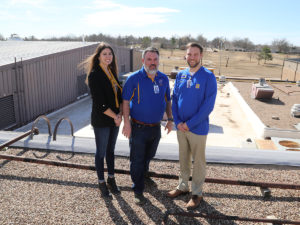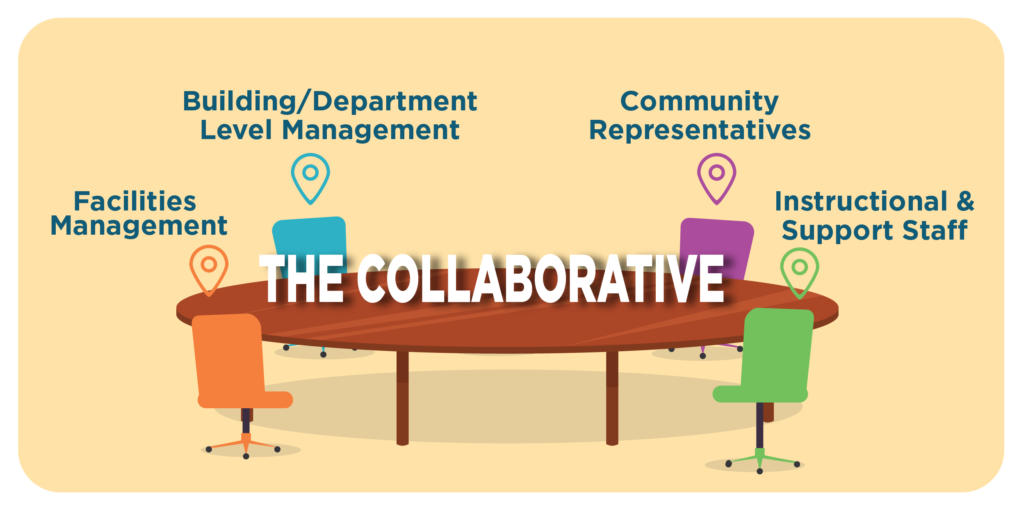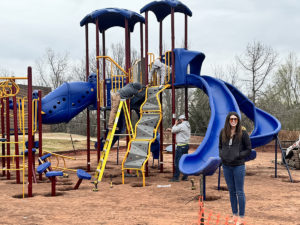Whether you’re a veteran leader in facilities management or just beginning your rewarding career in the field, it’s critical to understand the importance of collaboration. But actually collaborating can be easier said than done. We, two facilities management (FM) colleagues and one building-level site administrator who work together in a large-sized public school district in Oklahoma, have learned in our APPA CEFP coursework that 90% of the input and decisions happen within the first 10% of a project. Our experience has reinforced for us the need for educational facilities management professionals to be at the leadership table throughout the course of a project to ensure that our buildings and grounds provide students with the best learning environment, teachers with the best instructional settings, and community members with the best spaces in which to support and grow school pride.
In this article, we’ll draw from our experience at Stillwater Public Schools (SPS) to explore what collaborating on a facilities-related project can look like with key stakeholders in a K–12 setting, whether at the level of an individual site or the district more broadly. Elaborating on the “seat at the table” metaphor, we’ll also explore strategies for using trust to (if needed) rebuild the table, deciding who should be at the table, and providing specific examples of successful projects and collaboration demonstrating how everyone can indeed play a role.
Rebuilding the table
Change is necessary and inevitable. Within educational systems and institutions, implementing new systems and standards will almost always ruffle a few feathers. To earn our leadership seat at SPS, we learned to demonstrate our concern for student learning and school achievement, just as instructional staff must do. We also learned to effectively communicate our challenges even while resolving facilities-related issues such as space, furniture, HVAC, and custodial needs. Implementing change, after all, requires mutual trust. And trust, as difficult as it is to measure, is reflected in the results.

Left to right: Article co-authors Larin Davis, Rob Lamecker, and Kane Mach on a pre-construction visit for a roof and mechanical project at Stillwater Junior High School.
In 2022, we were a new facilities management team in our district. In collaboration with site-level leadership, we were tasked with transitioning to a new environment where needs would feel heard and the district’s overall vision would be maintained even as we worked with limited resources and a realistic budget. The process was difficult and faced us with varying degrees of adversity month after month as we built up the department to handle the demands of a large district. Buy-in became critical. New systems created strains on the organization that were not always apparent up front, such as the time and energy spent teaching and learning new policies, procedures, and pathways. Obtaining buy-in on the front end helped make this process less painful because everyone saw and understood the future benefit. Committees were another avenue to obtain buy-in; a few of our committees include safety and security, facility rental, capital projects, bond planning, and standards review. Granted, committees can also be a double-edged sword, as they take time and effort to manage and guide. But we found that allowing our stakeholders a voice helped to ensure that trust is maintained. District-wide standards require the same level of buy-in. Standards create consistency, streamline systems, and build a cohesive organization.
We also knew that our journey required us to build trust. As Patrick Lencioni wrote in The Five Dysfunctions of a Team, “Teamwork begins by building trust. And the only way to do that is to overcome our need for invulnerability.” In taking that advice, we analyzed our most successful collaborative partnerships and projects from the last several years to better understand how we had built trust and overcome invulnerability—in other words, acknowledging our infallibility as humans who were trying our best but may make mistakes that can be uncomfortable or painful.
We discovered that a facilities management team must do the following:
- Find the people in key positions who want to work with you to solve problems. Avoid those who actively work against you.
- Start building with those who are willing, but keep the door open to others. Not everyone will be ready to join your community and team, and that is okay.
- Incentivize teamwork between school leadership and facilities management. This can be accomplished through co-funding projects, offering in-house installation, recommending vendors, bumping up timeline priorities, etc.
- Make any collaboration meaningful, with the results to show. Ensure that you achieve more together than you would have alone or separately.
- Work as a team to market your successes and thus galvanize more participation.
- Disincentivize people from going it on their own. The most effective method is to establish and communicate new standards, and then develop new policies, procedures, and pathways for reaching and upholding those standards.
Who gets a seat?
The goal of any decision-making table is to make good decisions. This required us to think carefully about who on the facilities management team should be around any given table, depending on the project at hand.
Team selection is critical; unfortunately, it may be more of an art form than a science. People tend to choose others with a similar philosophy, to make decision-making more effortless, but we know that this path can be treacherous. Regardless of the project, we found it best to limit the number of people on any given team or committee. Too few people could mean too few ideas; too many people could make trust and good decisions difficult. We also concluded that the number-one factor in selecting those six should be whether the person would selfishly champion ideas best for their staff, their building, or the organization, depending on the team’s scope. Other factors to consider became whether potential team members would openly share their ideas, voice dissenting options, be willing to debate what is best, and provide a perspective we may not have already had.
Ultimately, we decided that most decision-making tables involving facilities projects should include individuals from four groups.

![]() Facilities management administration
Facilities management administration
The composition of your facilities management administration team will vary depending on the project. For instance, a non-capital project may involve only the associate leadership, leaving the director free to focus on capital projects. However, the majority of your team may be required at tables where policy, procedures, and systems are being discussed.
![]() Building/department-level administration
Building/department-level administration
When laying out your figurative seating chart, be sure to consider who the stakeholders will be at the level of the school, department, or district. In our experience, we found it best to have one point of contact (POC) per building when managing projects. This POC can then follow up as needed with their building’s stakeholders and the facilities team more broadly, streamlining communications.
![]() Department/instructional and support staff
Department/instructional and support staff
Although administrators will be the primary stakeholders at a site-specific project, many more individuals need a seat. They may include students, parents, or other staff members who will be impacted by the project or system. Ensure the support staff feel heard and understood.
![]() Community representatives
Community representatives
Because SPS constitutes public K–12 institutions, the public will always have a seat at the table in the sense that we are working with their tax dollars. However, other than electing board members and voting on bonds, members of the local community may often feel the need to be included, and their perspective can add value to the conversation.
Here’s an example: We hold quarterly Safe and Healthy Schools meetings within one of our secondary sites. The table we built for this team includes seats for the site administrator, facilities management administrator, teacher/support staff/parent/student representatives, a school resource officer, a school nurse, site and district counselors, our child nutrition director, and a community member. With these key players present, we discuss ongoing facilities projects, safety/security, student/staff wellness, and community building, and we address any concerns brought forth to the team. It is amazing how simply, efficiently, and thoroughly issues are communicated and solutions are hashed out with the right people at the table.
Leveraging community resources
Nearly everyone in any community has a student in their family or knows a student in the local school district. Often in our line of work, success is measured in the long term—but it’s important to keep in mind that short-term wins add up too. That’s why we recommend that the FM team support the community whenever possible.
We are fortunate in the SPS district to have a large university as a neighbor. They have been a valued partner in sharing ideas and providing feedback as we’ve developed and implemented new district standards, policies, procedures, and pathways. We had a moment of epiphany during a recent visit to the university, when we noticed that all of its trees had mulch rings around them to ease mowing and minimize trimming. Within a few short weeks, we procured a mulcher and implemented this standard in a way that works for our district. We found that while our operations are different in many ways, they are also very similar, offering opportunities for collaboration and learning.
Similarly, we love financial donations and in-kind work from local businesses and companies within our school district. Allowing people to donate work establishes trust within the community while building buy-in and pride in the facilities themselves. However, these transactions require us to create a process and procedures to ensure that the work is completed to district standards and does not open doors for liability or Title IX issues. Our process and policies also help ensure that people’s donated time and money are not wasted. And let’s not forget our wonderful vendors. Without them and their materials, none of our successful projects would be possible. Vendors are a valuable resource and should be brought along through the process as a partner.

Author Larin Davis (foreground) at the site of a new playground being built for Richmond Elementary School.
For example, at one of our secondary sites, we used specific strategies to build trust, overcome invulnerability, and collaborate with the administrative team to complete several improvement projects. These included a new classroom space for English language learners, a new wellness space in the freshman hallway (complete with handicap-accessible water fountains and a bottle-filling station), and re-sodding the center of the football field. All of these projects were funded through a joint effort involving the facilities management budget, site facility rental profits, and grant funding dollars written and received by the school.
In another example, a simple request to replace a broken slide at an elementary school site resulted in a massive joint fundraising effort that involved included grant funding, community donors, facilities management, the school, and the parent-teacher organization coming together to replace the entire playground within a year.
These and other successful projects resulted from collaboration, with each entity taking a seat at the table and contributing to the discussion. Attempting any of these projects without every entity would have cost more, taken longer, and produced lesser results. We’re proud that the facilities management team spearheaded this focus on collaboration, starting by redefining what the table itself should look like. Teamwork makes the dreamwork by simply ensuring everyone has a meaningful seat at the table!
Kane P. Mach, PhD, CEFP, is the assistant principal and athletics coordinator at Stillwater Junior High School. He has more than 10 years of experience as an educator and administrator at various levels. He can be contacted at [email protected].
Rob Lamecker, CEFP, is the director of facilities management in the Stillwater Public Schools district. He brings more than 20 years of experience in information technology leadership to the table and can be contacted at [email protected].
Larin Davis, MA, CEFP, is the assistant director of facilities in the Stillwater Public Schools district. She transitioned into that role after several years as a high school and elementary special education teacher. She can be contacted at [email protected].



